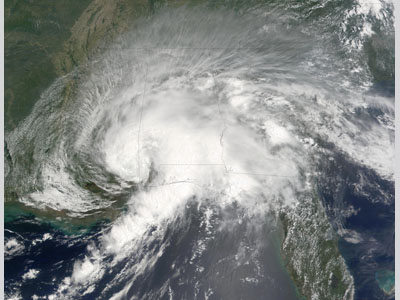In June of 2001, Tropical Storm Allison became the first named storm of the 2001 hurricane season and would be the only tropical system to make landfall in the U.S. that year. It would go on to ravage U.S. coastal areas with torrential rains and flooding for nearly two weeks and became the costliest natural disaster in the history of Houston, Texas. The storm originated from a tropical wave off the coast of Africa on May 21, 2001. The wave moved west across the Atlantic Ocean, entered the Caribbean Sea by 29 May, and then crossed over southeastern Mexico into the eastern North Pacific Ocean on 1 June. A southerly flow then forced the system inland over extreme southeastern Mexico and western Guatemala. On 4 June, the storm crossed the Yucatan Peninsula, entering the Gulf of Mexico early on 5 June. By 1200 UTC on 5 June, satellite imagery and surface observations suggested that the system had developed into a tropical storm, Tropical Storm Allison, about 221 kilometers (128 miles) south of Galveston, TX. During its development, the storm quickly strengthened, producing 96 km/h (60 mph) winds, some of which extended more than 320 kilometers (200 miles) east of the storm’s center.
The tropical storm slowly tracked to the north-northwest, weakening slightly just before making landfall near Freeport, TX (with 80 km/h [50 mph] winds). Allison tracked slowly northward across western portions of Houston, TX, during the night of 5 June, deluging areas with 152-254 millimeters (6-10 inches) of rain in less than 5 hours. By 7 June, Allison had become a tropical depression, stalled out over eastern Texas. It eventually tracked back into the Gulf of Mexico early on 10 June at nearly the same location where it had made landfall as a tropical storm. Although the tropical system remained over warm water on the 10 June, very dry air in the troposphere, combined with moderate upper-level wind shear, inhibited the redevelopment of thunderstorms. Allison became a subtropical depression, however, and reintensified into a subtropical storm on 11 June. The storm tracked inland near Morgan City, LA, dumping 553 millimeters (21 inches) of rain in the area before passing through other states along the Gulf and Mid-Atlantic coasts. The storm eventually cleared the United States mainland on 17 June and merged with a cold front on 18 June (becoming extratropical), before dissipating southeast of Nova Scotia on 19 June. Allison’s heavy rains produced catastrophic flooding over portions of coastal Texas, and significant flooding throughout the rest of the Gulf and Mid-Atlantic States. Nearly 90% of the total losses for Tropical Storm Allison occurred in the Houston metropolitan area. Rainfall rates measured across Harris County (Houston) exceeded 25 cm (10 inches) in 10 hours or less, and nearly 940 millimeters (37 inches) of rain fell in total. As a result of Allison’s drenching rains, 5 of the 6 major bayous running through central Houston overtopped their banks, and 4 of them (Greens, Buffalo, Halls, and White Oak bayous), exceeded their 100-year flood levels. The maximum rainfall rate recorded for Allison was in the Greens Bayou watershed where 724 millimeters (28.5 inches) of rain fell in approximately 10.5 hours. Heavy rain and flooding also occurred in Louisiana. The southeastern city of Thibodaux, LA flooded when 385 millimeters (15.2 inches) of rain fell in 24 hours. The city reported a rainfall total of 757 millimeters (29.8 inches). Significant floods also occurred in northeast North Carolina and southeast Pennsylvania, with areas measuring 254 millimeters (10 inches) of rain within 6-12 hours. Forty-one deaths were directly related to the flooding, lightening, and tornadoes generated by Tropical Storm Allison with 23 fatalities occurring in Texas, 8 in Florida, 7 in Pennsylvania and others elsewhere. Overall, Tropical Storm Allison is estimated to have caused over $5 billion in damages (2001 USD; $6.77 billion 2009 USD). Much of this damage occurred in TX, approximately $4.9 billion (2001 USD) in the Houston metropolitan area alone. Damage estimates in the Houston area include: $2.04 billion to public facilities (especially the Texas Medical Center—due to flooding, 9 of 13 hospitals had to close), $1.76 billion to residential properties, and $1.08 billion to business. Louisiana and Pennsylvania were also seriously impacted by the storm. In Louisiana, the storm caused flooding to over 1,000 houses in St. Tammany Parish, 80 houses in Saint Bernard Parish, and hundreds of houses in other parts of the state. Allison caused a 0.76-meter (2.5 foot) storm surge in the southern town of Cameron, LA, which resulted in the flooding of several sections of Louisiana Highway 82. Overall, damage in Louisiana was estimated at $65 million (2001 USD). In Pennsylvania, the storm washed out roads, bridges, and several Southeastern Pennsylvania Transportation Authority (SEPTA) rail lines, and damaged thousands of homes across the southeastern part of the state. Overall, an estimated $215 million (2001 USD) of damage occurred in Pennsylvania. Fast Facts:
Sources:
National Hurricane Center Tropical Cyclone Report for Tropical Storm Allison: National Weather Service (NWS) Houston/Galveston, TX, Tropical Storm Allison Research Project: NOAA Climate Watch- Tropical Storm Allison NOAA/NHC Hurricane History: Tropical Storm Allison Flood Safety and Tropical Storm Allison FEMA- Tropical Storm Allison Recovery Project NOAA Precipitation Page for Allison: Tropical Storm Allison Summary NOAA Hydrometeorological Predication Center (HPC). 2006. Rainfall Totals from Tropical Storm Allison. Tropical Storm Allison Heavy Rains and Floods Risk Management Solutions (2001). "Tropical Storm Allison Event Report" http://www.rms.com/Publications/TS_Allison.pdf Tropical Storm Allison |


